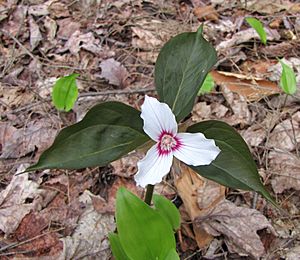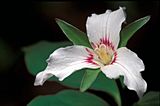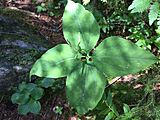Painted trillium facts for kids
Quick facts for kids Painted trillium |
|
|---|---|
 |
|
| Conservation status | |
| Scientific classification | |
| Genus: |
Trillium
|
| Species: |
undulatum
|
| Synonyms | |
|
|
Trillium undulatum, the painted trillium, is a species of flowering plant in the family Melanthiaceae. It is also known as painted lady (not to be confused with a painted lady butterfly), smiling wake robin, or trille ondulé in French. The plant is found from Ontario in the north to northern Georgia in the south and from Michigan in the west to Nova Scotia in the east. It demands strongly acidic, humus-rich soils and tends to be found in the shade of acid-loving trees such as eastern white pine, red maple, red spruce and balsam fir. Although the soils that support it have low base saturation, this species was found to have relatively high levels of calcium, magnesium, and especially potassium in its foliage.
Trillium undulatum is a perennial herbaceous plant that spreads by means of underground rhizomes. There are three large leaf-like bracts arranged in a whorl about a scape that rises directly from the rhizome. Bracts are ovate, each with a definite petiole.
Flowering occurs from late April to the end of June. The single, terminal flower is pedicellate with three sepals and three petals. The petals are wavy-margined and white with a central red to reddish purple splotch at the base of the flower.
After anthesis, if the flower was successfully pollinated, a single fruit develops. Initially the fruit is green, ripening to a bright red by mid to late summer. The fruit is a berry-like capsule, 1 to 2 cm (0.5 to 1 in) long. No other North American Trillium species has a fruit of this size and shape.
Numerous abnormal forms have been reported including variants with multiple whorls of bracts, enormous sepals, or four or more parts (instead of the usual three), the latter being somewhat common in T. undulatum. A form with unmarked white petals occurs in the southern Appalachian Mountains.






